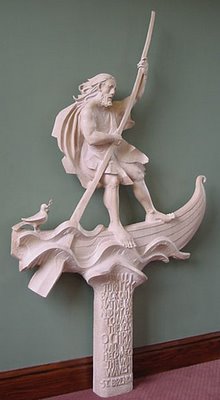
I know it's a few days late...but here is the article I intended to post on St. Patrick's Day.
-------------------------
Of Sainted Memory This St. Patrick's Day why not drink to St. Brendan?
BY JOHN J. MILLER Friday, March 11, 2005 12:01 a.m. EST
This time next week, many Americans will wake up wondering why they had partied so hard the night before. A better question might be why they honor St. Patrick at all, because he is not the most fitting patron saint for Irish America.
The problem isn't that Patrick is objectionable in any way. As the man who brought Christianity to Ireland, he is obviously a figure of enormous significance. Yet there is nothing distinctively American about him--and Irish-Americans have a better choice in St. Brendan.
In the year 486, about a generation after Patrick's death, Brendan was born near Tralee, on the southwest coast of Ireland. Few hard facts are known about his life except that he founded a monastery at Clonfert and established several other enclaves around the British Isles--making him one of the fellows who laid the groundwork for Irish monks to "save civilization," as Thomas Cahill's best-selling account has it, when the rest of Europe was losing its heritage.
But that's not what makes Brendan special for Irish-Americans. His connection to them comes from the legends surrounding his other feats, which became popular tales in the Middle Ages. "The Voyage of St. Brendan" describes our hero leading a group of monks on a seven-year quest in search of a promised land that supposedly lay across the vast western sea.
The story features plenty of fantastic elements, such as fire-breathing sea monsters, an encounter with Judas Iscariot and a friendly whale who lets the pilgrims hold a Mass on his back at Easter. Several literary types have labeled the "Voyage" a Christian version of the "Odyssey," and it certainly includes adventures rivaling those in Homer's classic.
It is plainly a work of imaginative fiction. But does it also contain any kernels of truth? There is no doubt that Brendan was an extraordinary traveler. For Catholics, he is a patron saint of sailors. What is more, Irish monks are perhaps history's greatest unheralded seafarers. Many of them craved geographic isolation, where they could lead simple lives of prayer. This drove them to seek places so far off the beaten path that nobody else had been there before. (Or at least no other Europeans.)
The Vikings are usually given full credit for their bold exploration and settlement of the North Atlantic. Yet Irish monks actually beat them to Iceland, may have reached Greenland before they did and just possibly set foot in North America prior to Leif Ericson dubbing it Vinland.
This final claim can't be proved. There is no archaeological evidence for it, just as there was no archaeological evidence for Vinland before 1960, when Helge Ingstad stumbled upon the L'Anse aux Meadows site in Newfoundland and confirmed that the old Norse sagas were true: The Vikings came before Columbus.
Yet serious scholars also have put their faith in these daring Irish monks. "Norsemen discovered the New World about the year 1000," wrote Samuel Eliot Morison, Harvard's celebrated naval historian, in The Oxford History of the American People, "and an unknown Irishman probably did so even earlier."
Almost three decades ago, Tim Severin decided to test the idea. Using only materials available in sixth-century Ireland, he built a traditional Irish curragh from ash trees and ox hides, christened it Brendan, and set sail from Ireland's west coast. On June 26, 1977, he reached Newfoundland.
This resolved nothing, of course. But just as Thor Heyerdahl's Kon-Tiki and Ra expeditions opened the world's eyes to the possibility of surprising migrations, Severin helped show that the Brendan legends represent more than a theory for ethnic-pride crackpots.
If Irish monks really did make it to the Western Hemisphere, then perhaps Brendan is best understood as America's first immigrant. The story of Irish America, at least in its initial phases, is essentially the epic of a people who uprooted themselves, crossed an ocean and made homes in a place they'd heard about but had not seen.
And if the notion of displacing St. Patrick's special place on the calendar is too much to abide, then we can compromise: two parties instead of one. Or perhaps more piously, St. Brendan's feast day on May 16 can be devoted to good works as well as good ale.
Mr. Miller is a writer for National Review.

No comments:
Post a Comment